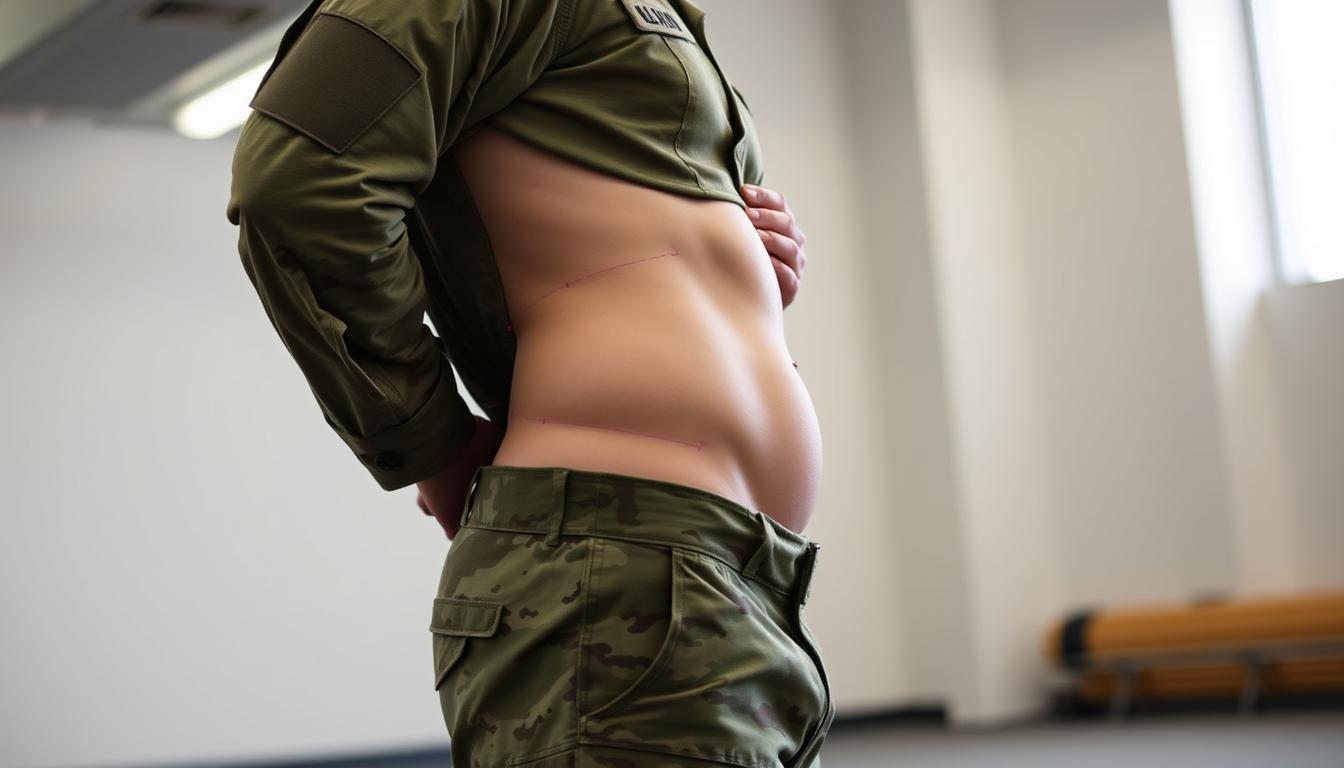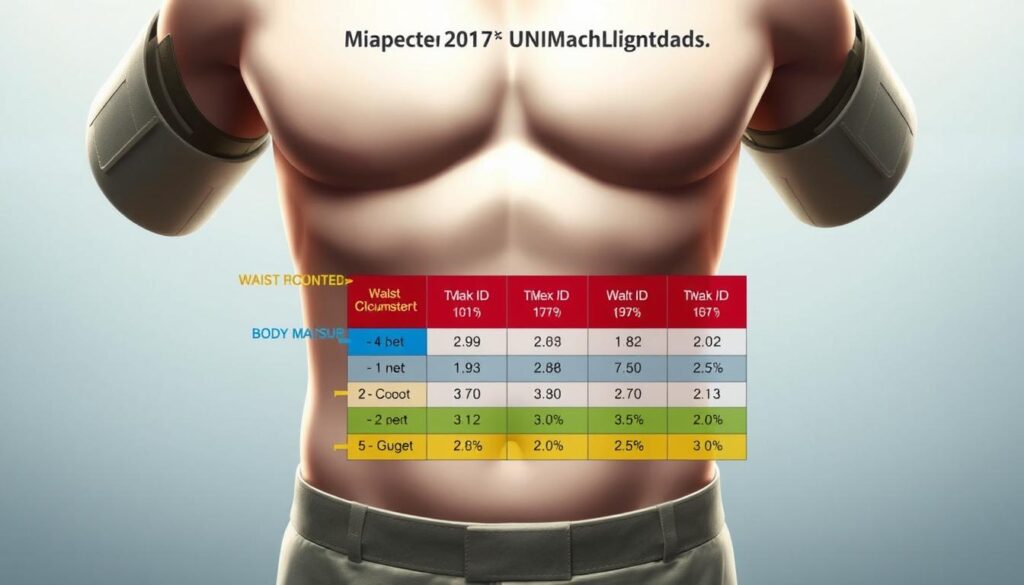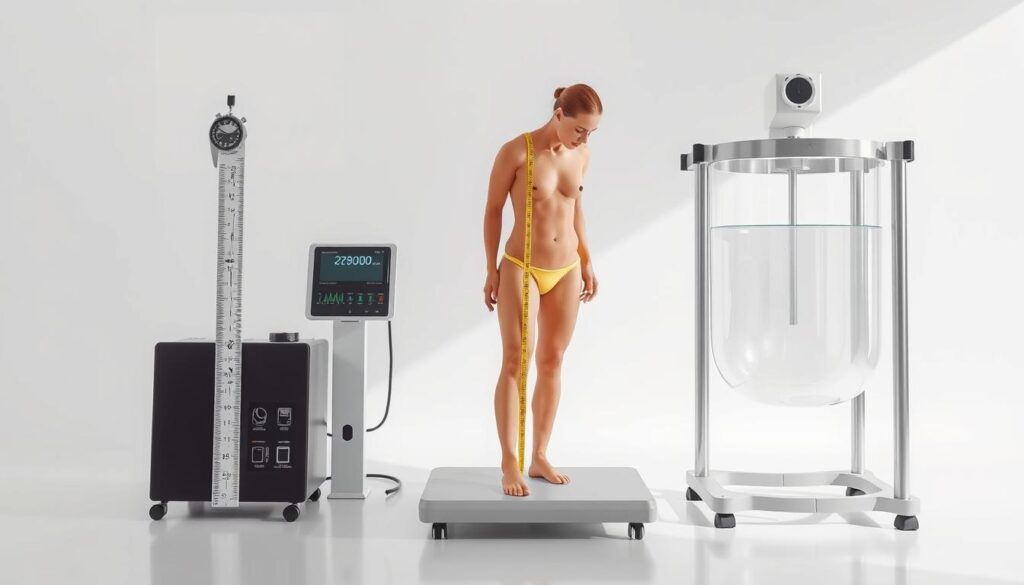Do you know how the U.S. military checks its soldiers’ fitness? The US Army body composition program is key. It makes sure everyone stays healthy and performs well, no matter the situation.
The program uses a few methods to measure body fat. For example, the tape test checks waist and neck size to guess body fat percentage. To learn more about measuring body fat accurately, check out our guide on how to measure tape test accurately.
Key Takeaways
- The US Army uses various methods to assess body fat, including the tape test.
- Body fat percentage standards vary by age and gender.
- The tape test is cost-effective, portable, and provides quick results.
- Soldiers with lower body fat percentages tend to perform better on fitness tests.
- A small increase in body fat can significantly impact performance.
Understanding Body Fat Measurement in the Army
Body fat measurement is key in the Army’s fitness standards. The Army sets body fat standards to keep soldiers fit. This is important for their performance and health.
Importance of Body Fat Standards
The Army’s body fat standards help soldiers stay fit for duty. Keeping the right body fat percentage is crucial for top physical performance. Soldiers not meeting these standards might join the Army Body Composition Program. This program helps them reach the needed body fat percentage.
Body fat standards are important for several reasons:
- They improve physical performance.
- They lower the risk of injury.
- They boost overall health.
How Body Fat Affects Performance
Body fat percentage greatly impacts a soldier’s performance. Too much body fat can lower endurance and mobility. It also increases injury risk. But, the right body fat percentage boosts performance and endurance, and lowers injury risk.
The Army’s body fat standards are based on the fact that too much body fat hurts performance. For example, too much body fat:
- Reduces aerobic capacity.
- Impairs muscular strength and endurance.
- Increases the risk of heat-related illnesses.
Overview of Army Regulations
The Army has rules for body fat measurement to keep standards consistent. These rules cover how to measure body fat, the standards soldiers must meet, and what happens if they don’t.
Some key parts of the Army’s regulations are:
- They use circumference-based measurements to check body fat.
- They require soldiers to meet specific body fat percentage standards based on age and gender.
- They outline how soldiers who don’t meet standards can join the Army Body Composition Program.
Common Methods of Body Fat Measurement
The Army uses several ways to check body fat, making sure everyone meets the standards. These methods help see if someone is fit and ready. The main ways include measuring body parts, skinfold tests, and bioelectrical impedance analysis.
Circumference Measurement
Circumference measurement is simple and doesn’t hurt. It measures the waist and neck to guess body fat. It’s easy to do and needs little equipment.
Skinfold Measurements
Skinfold measurements pinch the skin to measure fat thickness. It needs trained people to be right. It shows where fat is.
Bioelectrical Impedance Analysis
Bioelectrical impedance analysis (BIA) uses a small electric current to measure body resistance. It guesses body fat based on how well electricity flows. BIA devices are easy to use and give fast results.
The following table summarizes the key features of each method:
| Method | Description | Advantages | Disadvantages |
|---|---|---|---|
| Circumference Measurement | Measures body circumference to estimate body fat | Simple, quick, and non-invasive | May not be accurate for all body types |
| Skinfold Measurements | Measures subcutaneous fat thickness | Provides detailed fat distribution insights | Requires trained personnel; can be invasive |
| Bioelectrical Impedance Analysis | Estimates body fat using electrical resistance | User-friendly, quick results | Accuracy can be affected by hydration levels |
Each method has its role in the Army’s body fat checks. They offer choices for different situations. Knowing what each method does is key to managing body fat well.
Circumference Measurement Techniques
The Army uses circumference measurement to check body composition. It’s simple and works well to measure body fat percentage. This method takes body measurements at certain points to guess body fat.
Waist Measurement Protocol
To get a good waist measurement, stand up straight with your arms by your sides. The tape should be around your belly button, level and not too tight. Consistency is key for reliable results.
The Army says the tape should be snug but not tight. Take the measurement after a normal breath out. This makes the measurement as accurate as it can be.
Hip Measurement Protocol
Hip circumference is also important. Find the widest part of your hips, usually around the greater trochanters. Take the measurement with the same care as the waist to get it right.
- Stand upright with feet together.
- Ensure the tape is level around the hips.
- Take the measurement at the maximum circumference.
Interpreting Circumference Results
After taking waist and hip measurements, you can guess body fat percentage. The Army has a formula that uses these measurements, age, and gender. Accuracy in measurement is key for a correct assessment.
“The circumference-based method provides a practical and relatively quick way to assess body fat, making it an invaluable tool for military personnel.”
By following waist and hip measurement protocols and understanding the results, you can use this technique to check body fat. This method is simple but needs attention to detail for accurate results.
Skinfold Measurement Techniques
Skinfold measurements are key in the military body fat test. They involve pinching the skin at certain points to measure fat thickness.
The accuracy of these measurements depends on the person taking them and the equipment used. The Army has set standards to make sure everyone gets the same results.
Key Sites for Skinfold Measurements
The Army has specific spots for skinfold measurements. These are:
- The abdominal region, just to the right of the belly button.
- The triceps area, at the back of the upper arm.
- The suprailliac region, just above the hip bone.
Finding these spots correctly is very important for getting accurate measurements.
Tools and Equipment Needed
To take skinfold measurements, you need:
| Equipment | Description |
|---|---|
| Skinfold Calipers | Precision instruments to measure skinfold thickness. |
| Measurement Tape | Helps find the right spots for measurements. |
Make sure the skinfold calipers are set right for accurate readings.
“The precision of skinfold measurements is highly dependent on the technician’s expertise and the quality of the equipment.”
Accurate Measurement Practices
To get accurate skinfold measurements, follow these steps:
- Take multiple measurements at each site to ensure consistency.
- Ensure the skinfold calipers are held perpendicular to the skinfold.
- Maintain the pinch while taking the measurement.
By sticking to these practices, you can accurately measure body fat percentage. This meets army body fat standards.
Bioelectrical Impedance Analysis
The US Army uses bioelectrical impedance analysis to measure body fat percentage. This method sends a small electrical current through the body to estimate body composition.
Technology Overview
BIA technology works by sending an electrical current through the body. Muscle tissue, full of water, conducts well, while fat does not. By measuring resistance, BIA devices can guess body fat.
Factors Affecting Accuracy
Several things can make BIA measurements less accurate. These include:
- Hydration levels: Being dehydrated can lead to inaccurate readings.
- Recent exercise: Exercising before a BIA test can affect hydration levels and thus accuracy.
- Ambient temperature: Extreme temperatures can influence body water distribution.
- Device quality: The accuracy of BIA devices can vary significantly.
It’s important to standardize conditions before taking BIA measurements to ensure reliability.
Interpreting BIA Results
Understanding BIA results means knowing what the device shows and comparing it to standards like the US Army body fat percentage chart. Results should be seen in the context of overall health and fitness, not just body fat percentage.
Knowing how BIA works and what affects its accuracy helps people understand their results better. This way, they can make informed decisions about their health and fitness goals.
Comparing Different Measurement Methods
To find the best way to measure body fat, we need to look at the Army’s methods. The Army uses methods like circumference, skinfold measurements, and bioelectrical impedance analysis (BIA). Each method has its own good points and areas for improvement.
Accuracy and Reliability of Each Method
How accurate and reliable each method is varies. Circumference measurement works well for groups but might not be as precise for everyone. Skinfold measurements are very accurate if done right, but they need skill. BIA is easy to use but can be influenced by how hydrated you are.
Reliability Comparison:
| Method | Reliability | Accuracy |
|---|---|---|
| Circumference Measurement | High | Moderate |
| Skinfold Measurements | Moderate | High |
| Bioelectrical Impedance Analysis | Moderate | Moderate |
Pros and Cons of Common Techniques
Each method has its own benefits and drawbacks. Circumference measurement is fast but might not be right for everyone. Skinfold measurements are very accurate but need expertise. BIA is easy and doesn’t hurt but can be influenced by many things.
“The choice of body fat measurement method depends on the specific requirements of the assessment, including the need for accuracy, the availability of equipment, and the skill level of the personnel performing the measurement.”
Pros and Cons:
- Circumference Measurement: Quick, easy, but potentially less accurate for non-standard body types.
- Skinfold Measurements: Highly accurate with proper technique, but requires skill.
- BIA: Convenient and non-invasive, but affected by hydration levels and other factors.
Selecting the Right Method
Choosing the right method depends on several things. These include the purpose of the measurement, the equipment you have, and who is doing the measurement. For example, circumference might be good for big groups, while skinfold measurements are better for when you need to be very accurate.
By knowing the good and bad of each method, you can choose the best one for your needs.
Recent Advances in Body Fat Measurement
The Army keeps updating how it measures body fat to make sure soldiers are ready for duty. New tech has brought fresh ways to check body composition.
Emerging Technologies
New tools like dual X-ray absorptiometry (DXA) and air displacement plethysmography (ADP) are being used. They give precise body fat readings. This is key for knowing an individual’s army body fat percentage chart status.
AI in Measurement Techniques
Artificial Intelligence (AI) is making body fat checks more accurate and quick. AI looks at data from tests like the army body fat tape test. It gives a full picture of body composition.
Future Trends
Future body composition analysis will likely include better imaging tech and AI models. These will help the Army keep its fitness standards high.



